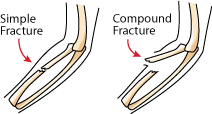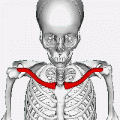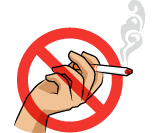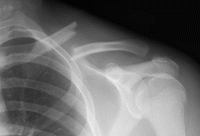show/hide words to know
Calcium: a mineral which makes bones hard and strong.
Compound fracture: a broken bone that has broken through the skin, also known as an open fracture.
Immobilize: to prevent something from moving.
Impact fracture: a broken bone that was caused by a sudden impact.
Osteoporosis: a disease, usually only seen in elderly people, where bones become weak and are easily broken... more
Pathological fracture: when disease makes bones weak, causing them to break more easily than healthy bones.
Simple fracture: a broken bone that has not broken through the skin, also known as a closed fracture.
Stress fracture: broken bones that result from pressure on the same spot over long periods of time.
How Do Bones Break?
Bones usually have no problem supporting your body as you go about your daily activities, including exercise and play. They are strong and flexible enough to absorb the light impact your body experiences during these activities. Once in a while, a bone is put under more stress than it can handle. When that happens, it breaks. A broken bone is called a fracture by doctors. There are three main types of fractures: stress fractures, impact fractures, and pathological fractures.
Bone Stress Over Time
Stress fractures happen when too much pressure is placed on the same spot on a bone over long periods of time. Over time, the pressure from small impacts weakens the bone until it begins to crack along the surface. These cracks can be very small at first but get bigger and bigger if they are not given a chance to heal.
A common stress fracture happens in the legs and feet of runners and athletes. Athletes make their bodies work very hard in order to become stronger and faster. They sometimes perform the same exercise many times in a row to become better at it and build larger muscles. Fractures are especially likely to happen when the muscles are tired. When the body is worn out, stress which would normally be absorbed by the muscle goes straight to the bone instead. The long thin bones on the top of the foot as well as the heel bone which absorbs the impact of every step when running are especially likely to fracture this way.
Impact Fractures
Sudden impact fractures happen when a bone takes a sudden, hard hit that puts more stress on it than it can handle at once. Unlike stress fractures that build up over time, impact fractures happen in a single moment, like snapping a dry piece of wood in half. Things that might cause impact fractures include a fall, a strong direct hit from an accident while playing a sport, or a car crash.
Sick Bones
Certain diseases can make bones thinner and more fragile. When that happens, it's possible for bones to break from regular everyday activities that would not normally cause a fracture in a healthy person. People who know that they have weak bones need to be extra careful and try to avoid doing things that cause sudden impacts to their bones.
Osteoporosis is one of the diseases that can cause weak bones. It occurs mostly in women and elderly people. This disease makes it more difficult for calcium and other minerals important to bone strength to stay in the bones. Luckily, simple lifestyle choices like good diet and exercise can help prevent osteoporosis, and help treat it once it's already begun. There are also many medications that can help.
Are All Broken Bones the Same?
 Now that you understand how bones break, let's take a look at the many different kinds of fractures.
Now that you understand how bones break, let's take a look at the many different kinds of fractures.
When a movie character breaks a bone, they usually end up with part of the bone poking out of their skin. This can happen, but doesn't happen every time a bone breaks. Fractures can be closed (simple) or open (compound). This tells you whether or not the bone has broken through the skin. A simple fracture, also known as a closed fracture, means that no part of the bone has broken through the skin. A compound fracture, also known as an open fracture, means that the bone has broken through the skin. There is a much higher risk of infection with compound fractures since the bone gets exposed to air, dirt, and bacteria from the environment. Because of this, compound fractures must be treated and watched much more carefully than simple fractures.
Fractures are also categorized based on the shape of the break. There are eight main shapes or kinds of bone fractures.

Types of bone fractures.
Transverse fractures go more or less straight across the bone.
Oblique fractures are diagonal breaks across the bone.
Spiral fractures happen when one or both halves of the bone are twisted.
Comminuted fractures break the bone into more than two pieces.
Avulsion fractures mean pieces of the bone have been pulled apart.
Impacted fractures are the opposite of avulsion fractures. These happen when a piece of bone is pushed down into another piece of bone.
Fissure fractures are cracks in the bone.
Greenstick fractures happen when the bone bends and breaks partially, but not completely. Have you ever tried breaking a fresh twig of wood? Instead of snapping in half like a dry piece of wood, it tends to break on the outside but only bend in the middle. This is what a greenstick fracture looks like. This kind of fracture is more common in children and teenagers than in adults. As a person ages, their bones become harder and more brittle. Kids' bones, on the other hand, are much more flexible. This makes them more likely to bend in the middle instead of breaking all the way through.
 Commonly Broken Bones
Commonly Broken Bones
What would you guess are the most commonly broken bones in the human body? If you guessed something in the arms or hands, you are correct! Bones in this area are more likely to be broken than bones in other parts of the body because we tend to use our arms and hands the most when trying to break a fall. As it turns out, the clavicle, also known as the collar bone, located between your shoulder and the front of the neck, is the bone which is most likely to get broken in the human body. The clavicles can be easily fractured by impacts to the shoulder, from the force of falling on outstretched arms, and by a direct hit.
In case you are wondering, here is the list of the top five bones commonly broken in the human body.
- Clavicle - as the number one most broken bone, there are many ways it can happen. This bone can even break in a newborn baby as they move through the birth canal. The good news is new born babies have bones that heal very fast.
- Arm - this can be the radius, or ulna bones in the lower part of the arm, or the humerus bone of the upper arm - which is not very funny.
- Wrist - like the arm bones, the wrist can end up with a lot of the force on them when we place our arms out during a fall - like when skateboarding.
- Hip - this bone is the most commonly broken bone for people over the age of 65. Women in this age group have the highest rate of fractures due to calcium loss (osteoporosis).
- Ankle - everything from taking a wrong step off a curb, or twisting an ankle playing sports or when out for a hike can cause a break. In some cases when you twist an ankle you might think you have something like a sprain, but broken ankles and sprains can seem similar. It is always good to check with your doctor if you hurt your ankle.
Detecting a Broken Bone
Broken bones sometimes feel and look the same as muscle pain or other kinds of injuries. This makes it very important for doctors to assess an injury before treating someone for a broken bone. There's usually swelling, bruising and pain when you touch or put weight on the injured spot. Stress fractures are especially tricky to detect due to the fact that they build up over time. Unlike impact fractures, there isn't always a specific moment when the break occurred which the patient can remember. So how do you know if your bone is really fractured?
The most common way to find out whether or not a bone is really broken is by taking an x-ray image of it. This also tells the doctor how bad the fracture is and exactly where it's located. Detailed bone scans are also sometimes used instead of x-ray images to detect very small cracks. These can be used to see itsy bitsy fractures that aren't always visible with an x-ray.
How to Fix a Broken Bone

A cast is used to immobilize broken bones.
The human body is very good at repairing itself after an injury, and it comes equipped with all the tools it needs to fix fractures. Doctors work together with the body by creating the best possible conditions for healing. After that, it's just a matter of standing back and giving the body time to do its job. Sometimes the body does such a good job at healing a bone that after it heals it's impossible to tell the bone was ever broken!
Cast
To create the perfect environment for a bone to heal, it's important to keep the broken bone in one place and prevent it from moving (also known as 'immobilizing' it). This provides support by taking pressure off the break so it will heal more quickly. It also keeps the pieces aligned to prevent the bone from healing crookedly.

X-ray of a bone with many plates and screws after surgery.
The most common way to immobilize and protect a broken bone is by putting a cast or splint around it. A cast is a hard shell usually made of plaster or fiberglass. A splint is a hard support similar to a cast which can be worn temporarily and is easily removed. Little bones such as toes that are too small for casts are usually held in place next to the other toes using special tape. If the broken bone is in the leg or foot, crutches are often used to keep weight off the injured leg. If part of the arm is broken, a sling can be used in addition to a cast to help hold it in place.
Surgery
Surgery is sometimes needed to help realign the bones when there are too many broken pieces or a very complicated fracture which won't stay still any other way. In these cases, metal screws, pins, rods, and plates are used to hold the bone together. Sometimes these are temporary and can be removed once the bone heals, but other times they're left in place permanently to help make the bone stronger.
How to Make Your Bones Stronger
You can't make sure that you will never fall off of your bike or fall down, but there are a couple of things you can do to help reduce the chance that you will break a bone from accidents like these.
 |
Exercise Physical activity is an important part of building strong bones. Many studies have shown bones that aren't used much become thinner and weaker over time, while bones that are used regularly during exercise become stronger and thicker from the stress of your muscles pulling on your bones. The stronger the bone, the less likely it is to break in an accident. Lifting weights and other high intensity activities are especially good for building strong bones. |
 |
Eat Healthy Bones need the right kind of nutrients and minerals from the food you eat to grow and become strong, which is why it's important to eat healthy, balanced meals every day. The two most important nutrients for bones are calcium and vitamin D. Calcium is used by most cells in your body to signal different processes. It's also what makes your bones strong and hard. Most of the calcium in your body, almost 99%, is stored in your bones. Your bones act like a warehouse, storing extra nutrients so they can supply calcium and other minerals to your body when it needs them. Calcium comes from dairy foods such as milk, cheese, and ice cream. Dark-green vegetables such as spinach, broccoli, and collard greens are a good source of calcium as well. Vitamin D helps to control how calcium and other minerals are used in the body and how much of these are getting stored in the bones. Vitamin D comes from liver, whole eggs, and certain fish. You can also get Vitamin D directly from sunlight on your skin! Many foods found in the grocery store, such as butter, cereal and orange juice, also now come fortified with vitamin D. Fortified means that extra nutrients have been added. |
 |
Don't smoke In addition to causing major damage to your heart, lungs, throat, and teeth, smoking cigarettes is bad for your bones. Tobacco smoke makes osteoblasts (the cells which create new bones) work more slowly, which means the bones of someone who smokes get thinner and more fragile over time. Weak bones are more likely to break from an impact and take longer to heal when broken. Luckily, bones slowly become strong again as soon as a person quits smoking. This is just one of the many good reasons that you should never smoke! |
View Citation
Bibliographic details:
- Article: Broken Bones
- Author(s): the Arizona Science Center
- Publisher: Arizona State University School of Life Sciences Ask A Biologist
- Site name: ASU - Ask A Biologist
- Date published: May 13, 2011
- Date accessed: April 17, 2024
- Link: https://askabiologist.asu.edu/how-bone-breaks
APA Style
the Arizona Science Center. (2011, May 13). Broken Bones. ASU - Ask A Biologist. Retrieved April 17, 2024 from https://askabiologist.asu.edu/how-bone-breaks
Chicago Manual of Style
the Arizona Science Center. "Broken Bones". ASU - Ask A Biologist. 13 May, 2011. https://askabiologist.asu.edu/how-bone-breaks
the Arizona Science Center. "Broken Bones". ASU - Ask A Biologist. 13 May 2011. ASU - Ask A Biologist, Web. 17 Apr 2024. https://askabiologist.asu.edu/how-bone-breaks
MLA 2017 Style

Be Part of
Ask A Biologist
By volunteering, or simply sending us feedback on the site. Scientists, teachers, writers, illustrators, and translators are all important to the program. If you are interested in helping with the website we have a Volunteers page to get the process started.









